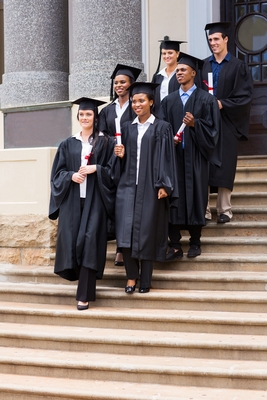
As graduation season draws to a close and the caps and gowns are put into cold storage until next year, there’s something else that’s being packed away that our students could desperately benefit from all year long: our willingness to pull back the veil of success to reveal the often messy process that built it— the hitches, glitches, setbacks and outright failures.
Take a quick scan of education in America, and it appears that college graduation speeches are just about the only place it’s safe to talk about failure without it sounding terminal. In wonderful speeches by
Oprah,
J.K.Rowling, and many others— failure is destigmatized. The inevitability of detours or mis-steps are seen as a rite of passage or a badge of courage—an essential growth accelerator on the bumpy road to success rather than something whispered in hushed tones and hidden from public view.
So there’s a disconnect. Step outside of the stadiums and auditoriums where graduations occur to the typical classroom in a landscape dotted by our children’s single point values of SAT scores and GPAs, and failure—even of the very teeniest scale—like guessing at an answer or saying, “I’m sorry I don’t know”— well, this is just not a space young people are willing (or encouraged) to occupy these days. When they do stick their neck out and get something wrong, I’m pretty sure thunderbolts appear and a swat team swoops down —We have a mistake here in Room 212!— leaving kids to swallow their pride along with their erroneously chosen words, and ensuring that as a result of this most unfortunate moment, any college that might be interested in them in the future—whether they are in 5th grade or 12th, will no longer be, or so the chorus of anxious thoughts goes.
There are no bad guys here. I do believe that. But we need to do a re-think as our desire for our children to have a good future has been overtaken by anxiety and a belief that the only way to get there is that every single move they make needs to be right. This is a message that comes through loud and clear: they’ve absorbed it every day.
Throughout their lives, our children have been told that every decision, every grade every extracurricular activity, essentially has to build toward their success— in college and beyond. Everything counts. The stress and anxiety are a given, settling in like big city smog. There are no mistakes. No good ones anyway. No room for error. Failure is out of the question, and yet so precipitously close. One false move on the tightrope walk through grade school, high school and college and you’re not bouncing back. You’re done.
Then suddenly graduation time comes and the message is—it’s okay to fail. And even fail big—Oprah big.
Since when? Students may ask, confused.
What do we do about this disconnect? If we want students to really understand this image makeover that failure is enjoying—we can’t just bring it out once a year with the pomp and circumstance—or after 12 or 16 years of hearing the polar opposite. That’s kind of like cramming for a test—the test of life—at graduation, when they could have been studying this particular unit about failure, resiliency and risk taking for years before. Is that really what we want to be encouraging?
Our job is to not wait for graduation to talk about failure and success. It’s a little late then. Rather, we need to be rolling out the red carpet for our kids throughout their education. Making saying “I don’t know” or making mistakes safe. Making “I don’t know for sure” a noble and defendable position.
How do we teach our children about this?
Just like we wouldn’t plunk a dog phobic child down in the middle of a busy dog park, but we’d desensitize slowly starting with the nice puppy safely in the pet shop window, we need to dissect failure—this kind of artisanal failure and find our first step. When we rewind back, we find that the seed of all success or failure is stepping out into uncertainty, saying “I’m not totally sure,” or even simply—“I don’t know.” This is where all great things begin. So it is our tolerance of uncertainty that we need to increase. The possibility of failure is always there and as we are gaining information we will also make mistakes along the way. Learning is not a one-off. It’s incremental.
One way to teach children the safety of mini-failures is to allow mistakes to enjoy a soft-landing. When kids get things wrong let’s not dismiss or embarrass, but appreciate the effort of going out on a limb. As one teacher in my daughter’s 8th grade class recently said when a student made a gaffe—hey—it’s every one’s job here to make this a safe place to learn. Amen.
Another is to turn the whole concept of failure on its head—and take the opportunity to point out not the fault when a mis-step occurs—but the exciting thing that’s about to happen—learning something brand new— and encouraging kids to revel in it!
And… if we are really putting our money where our mouths are about making tiny failures safe, my personal favorite (very nitty gritty) is to teach kids what to say in a moment of uncertainty. To have kids practice and cultivate a repertoire of their signature phrases such as “I’m not sure” or, “I don’t know.” Out loud. Really. Your child may never have uttered those words in a school setting. They can practice saying it many different ways getting more confident with each rehearsal: “You know, I don’t know,” or, “Well, I don’t actually know.” “That’s one I don’t get.” “I’m not really sure,” or, “I have to admit—I’ve never heard of that—though it sounds like I should and will in a minute.”
We can teach kids to have uncertainty with swagger, with personality, or simply with no shame. Does it mean that you don’t know anything if you admit that you don’t know this one specific thing? No! That’s just the temporary sting of how it feels. But over time of practicing your “I don’t knows” assiduously even the sting goes away. The “I don’t know”—becomes that freeing thing that we want failure to be.
Getting comfortable with failure starts with being willing to be wrong. To stand in the cold waters of not knowing and see that they warm up. Are we as adults willing to do that? We can really surprise and bolster kids by modeling what we don’t know: “This sounds really interesting, but I don’t know what you’re talking about. Can you explain it to me, because… I don’t know.”
Children may look in awe and disbelief. As much as kids (especially teens) think their parents don’t know anything a.k.a. everything—they are nevertheless shocked to hear that this might actually be the case.
So here we go, village, let’s make the conversation about adversity and failure part of every day use instead of just pulling it out for special occasions. We can start with the simple act of welcoming guesses, wrong answers, not knowing, and messing up by responding with the perspective that we want our children to have: this isn’t a big deal, just learn from it. I foresee a great “I don’t know” revolution. Can you imagine—kids everywhere asking questions and actually finding out information? Acquiring more information, not less standing, and clarifying, understanding, integrating and sharing what they know—and what they don’t know. In every classroom, uncertainty and curiosity being the invisible current that powers our lives. I don’t know— maybe I’m wrong about this, but I’m sticking my neck out for it anyway.
©Tamar Chansky, Ph.D., 2015. No part may be copied without permission of author.
CONNECT WITH DR. CHANSKY ON
FACEBOOK AND
TWITTER. IF YOU LIKE THIS ARTICLE, PLEASE SHARE IT WITH OTHERS!


 As graduation season draws to a close and the caps and gowns are put into cold storage until next year, there’s something else that’s being packed away that our students could desperately benefit from all year long: our willingness to pull back the veil of success to reveal the often messy process that built it— the hitches, glitches, setbacks and outright failures.
As graduation season draws to a close and the caps and gowns are put into cold storage until next year, there’s something else that’s being packed away that our students could desperately benefit from all year long: our willingness to pull back the veil of success to reveal the often messy process that built it— the hitches, glitches, setbacks and outright failures.

